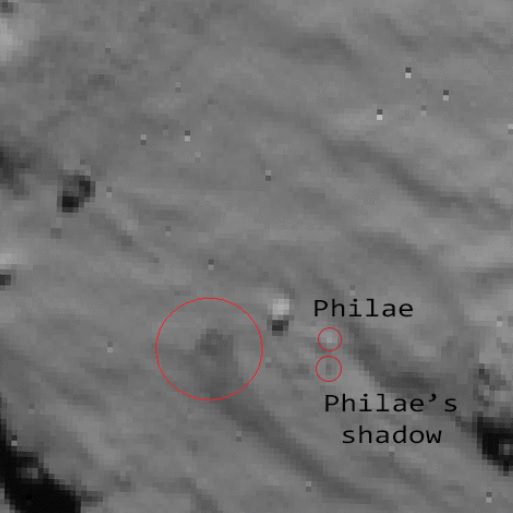When the Philae lander arrived at its target comet last week, the little spacecraft landed three times in two hours before coming to a rest. While controllers could see this information from data coming in, they didn’t have any photographic proof — until now.
The animation above, an enhancement of images from the orbiting Rosetta spacecraft released late last week, show Philae and its shadow –mid-bounce! — very shortly after landing on Wednesday (Nov. 12). Philae’s first jump lasted nearly two hours before it took off again, flew for another few minutes, and landed in a shady spot where its batteries drained on Friday.
Here’s another cool thing about these images — some of the credit to Philae’s discovery comes through crowdsourcing! This is what the European Space Agency’s Rosetta blog said about who found this:
Credit for the first discovery goes to Gabriele Bellei, from the interplanetary division of Flight Dynamics, who spent hours searching the NAVCAM images for evidence of the landing.
Once the images were published, blog reader John Broughton posted a comment to report that he had spotted the lander in them (thank you, John). There was also quite some speculation by Rosetta blog readers in the comments section, wondering which features might be attributable to the lander. Martin Esser, Henning, and Kasuha in particular were among the first to make insightful observations on the topic, although many others have since joined in.
Last but not least, a careful independent review of the images was made by Mikel Catania from the earth observation division of Flight Dynamics, with the same conclusion. He also made the annotated animation shown here.
This goes to show you that while there is disappointment that Philae is in a long (perhaps permanent) sleep sooner than scientists hoped, data from the spacecraft will continue to be analyzed in the coming months and years. And don’t forget that the orbiting Rosetta spacecraft is in good health and will continue to return data on 67P as it draws closer to the Sun through 2015.


Let’s move one step further…:
Why didn’t the anchoring system work…any idea from ESA?
And, where does the Philae rests ?
UT may coordinate a search (on images)…!
I agree. Very little has been said about why one of the more crucial parts of this operation miserably failed. Yet, there remains the oft chance the lander will gather more sunlight as the comet approaches perihelion and start functioning as intended.
The next 12 months ought to be quite the science bonanza thanks to New Horizon, Dawn and Rosetta.
Although it is still too early to tell with certainty, the anchoring devices didn’t perform as planned probably due to the surface being a lot harder than expected. When the MUPUS (multi-purpose sensors for surface and sub-surface science) experiment was deployed (on thursday?), the penetrator hammer broke. We’ll get to know more over the next few days. Crowd sourcing is already used to find the lander. And “miserably failed” ?? Not sure what mission you’re talking about. Perhaps you’re looking for the “Phobos-Grunt” thread…
Philae has survived years in the frozen depths before so it has a good chance of waking up if it gets more sunlight. As it is not tethered, when it approaches perihelion it might get blown off by outgassing and end up landing yet again. It may not be good science but it might get some amazing pictures. Fingers crossed.